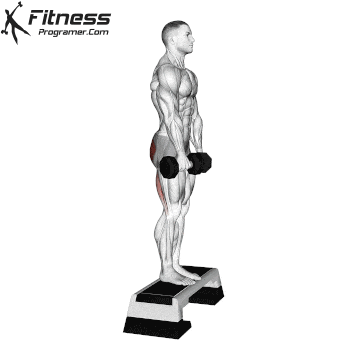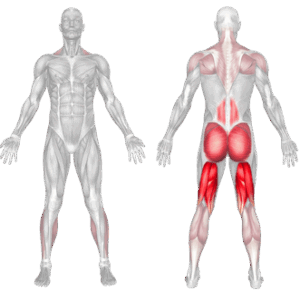Overview
The dumbbell Jefferson curl is an exercise that aims to increase both flexibility and spinal strength. It involves standing on a platform and slowly bending your spine forward with a weight (dumbbell, kettlebell, barbell). It’s particularly used in sports like gymnastics and weightlifting to strengthen the muscles that support the spine and improve range of motion.
How to Perform Dumbbell Jefferson Curl

Setup: Stand on a small platform or step to allow for a greater range of motion. Hold a light dumbbell in each hand with arms extended in front of your thighs.
Controlled Descent: Begin by tucking your chin, then slowly flexing your upper back, mid-back, and lower back in sequence. Allow the dumbbells to move downward as you gradually roll through each vertebra.
Stretch Phase: At the bottom, let the dumbbells hang naturally while maintaining slight tension, feeling a deep hamstring and spinal stretch.
Return to Start: Slowly reverse the movement to return to an upright position.
- Repeat: Perform the desired sets and reps, focusing on control and spinal segmentation.
Tips for Proper Form
Start with very light dumbbells, progressing gradually as mobility and control improve.
Keep knees straight but not locked to maximize hamstring engagement.
Move slowly, treating the exercise as both strength and mobility training.
Maintain control throughout; never “drop” into the bottom position.
Common Mistakes
Going Too Heavy Too Soon: Overloading increases injury risk and reduces mobility benefits.
Rushing the Movement: The exercise must be performed slowly to train spinal segmentation.
Locking Knees: Can reduce hamstring activation and increase strain on the joints.
Benefits of the Dumbbell Jefferson Curl
Improves Spinal Mobility: Strengthens the spine through controlled flexion, enhancing movement quality and reducing stiffness.
Strengthens the Posterior Chain: Engages hamstrings, spinal erectors, and glutes, building tissue resilience across the back body.
Enhances Hamstring Flexibility: Provides a deep stretch that lengthens hamstrings while simultaneously building strength.
Develops Core and Spinal Stability: Strengthens stabilizing muscles of the core and back, improving posture and control.
Injury Prevention and Resilience: Trains the body safely in ranges of motion where it is often weak, reducing risk of hamstring or spinal injury.
How to Incorporate Into Your Routine
For Beginners: Use bodyweight or very light dumbbells for 2–3 sets of 6–8 reps to build comfort with spinal flexion.
For Mobility and Flexibility: Perform 2–3 sets of 8–10 reps at the end of workouts, focusing on range of motion and spinal control.
For Strength Development: Gradually progress to moderate weights, performing 3–4 sets of 6–8 reps with slow tempo.
For Rehabilitation and Injury Prevention: Include 2 sets of 10–12 reps using very light dumbbells, under professional supervision if recovering from back issues.
Dumbbell Jefferson Curl: Muscles Worked
The exercise primarily emphasizes the posterior chain while also recruiting stabilizers in the core and upper body. It is especially valuable for improving hamstring flexibility, spinal mobility, and posterior chain strength under lengthened positions. Here’s a breakdown of the muscles worked:

Frequently Asked Questions (FAQs)
Is the dumbbell Jefferson curl safe?
Yes, if performed with proper technique, slow control, and appropriate weight progression.
Should beginners use weight right away?
No, start with bodyweight and progress to very light weights once form is mastered.
How often should I do Jefferson curls?
Two to three times per week is ideal for improving mobility and flexibility.
What weight should I start with?
Start with bodyweight or a very light dumbbell (2–5 kg), then progress gradually.
Can Jefferson curls help with lower back pain?
They may improve mobility and reduce stiffness, but consult a professional before using them for pain management.
